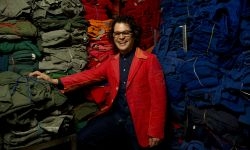Berlin recycled chic rebels against ‘fast fashion’

The floor of Daniel Kroh’s workshop near Berlin Central Station is littered with piles of orange overalls and the fluorescent reflector jackets worn by German railway workers.
They are the raw materials for this designer, who cuts and dyes the scraps to make men’s fashion.
“I seek traces of authenticity,” Kroh explains about his unique creations, his answer to cheap and mass-produced garments made for the world in faraway textile workshops.
He and a growing band of Berlin designers specialise in giving new life to textile waste to produce trendy and high-quality products.
Kroh also uses the blue work pants of carpenters, which would otherwise likely be burned in a garbage incinerator, to make new tailored clothes for the city’s hippest fashion pioneers.
The trend, a stance against waste and over-consumption, is not a new idea, the designers say.
“My mother and my grandmother … made new skirts with pieces from dresses or offcuts from coats, just to be economical,” says Italian designer Carla Cixi, who has lived in Berlin for five years.
Cecilia Palmer, another fashion designer in the German capital, lamented that in today’s world “we throw away clothes because of a missing button or a broken zipper”.
The designer, who is in her 30s, organises parties where everyone brings clothes they no longer want to trade for other pieces. Participants can also make new clothes with the sewing machines provided.
‘Like going to a fast food joint’
The big idea of the project? “Consume differently,” says Palmer, who
decries the fact that tonnes of clothing end up in the garbage each year.
These designers are rebelling against what they dub “disposable fashion”.
“It’s a scandal that some brands sell clothes that will be worn just two or three times” before they are considered outdated, said Cixi, whose crocheted creations require hours of work.
Shopping at global fashion retail chains “is like going to a fast-food joint to eat hamburgers. You feel bad afterwards,” said Kroh, who scoffed at mass market clothes as having “no soul”.
The designers complain that from Athens to Oslo, European youth wear the same slim-fit jeans produced in Bangladesh or Cambodia, with millions sold at unbeatable prices.
It’s a fashion that pleases everyone but “ends up being all the same,” Cixi said.
Each jacket or suit made by Kroh includes explanations about its origin.
Eugenie Schmidt and Mariko Takahashi, who also created a recycled clothing label, have also opted to “tell the story” of each dress or pair of pants from their workshop in the former East Berlin.
“The more a garment is worn, the more it contains of the history of the person who wore it,” said Schmidt, showing off a part-transparent pink creation with stains on the sleeves.
“These are traces of paint,” said Schmidt, explaining that the sweatshirt’s last owner was a painter.
The catch with recycled clothing, often produced in labour-intensive ways, is that it remains unaffordable for many. A jacket can easily cost more than 400 euros ($540).
The designers recognise that their style still serves a niche market. But they proudly defend it, denouncing the fact that the big chains sell T-shirts for as little as five euros.
A newcomer among the mega-retailers, Irish chain Primark, has used very low prices — without advertising — to lure tens of thousands to each store opening in Europe.
In Berlin, as elsewhere, shoppers pile out of the stores loaded with full bags. The rock-bottom prices are in turn fuelling controversy over labour conditions among garment makers.
With an eye for irony, Schmidt and Takahashi make most of their clothes from old H&M and Zara garments.

